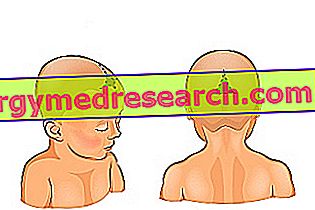Related articles: Infective endocarditis
Definition
Infective endocarditis is an inflammation of the inner lining of the heart (called endocardium) and of the heart valves, caused by an infection.
Under normal conditions, infectious agents do not easily adhere to the endocardial surface and continuous blood flow helps prevent colonization of cardiac structures.
Infective endocarditis occurs when microorganisms - coming from other parts of the body (skin, oral cavity, bowel or urinary tract) - spread through the bloodstream (bacteremia), overcome the normal immune response to infections and reach the heart where they take root .
Factors that predispose to infection are acquired or congenital heart diseases (eg valvular disease, rheumatic fever and hypertrophic cardiomyopathy) and implantation of valve prostheses.
Endocarditis can also result from invasive dental, medical or surgical procedures.
The causative microorganisms vary according to the site of infection and the source of bacteremia, but more commonly the infection of the endocardium is of bacterial origin (streptococci and staphylococci cause 80-90% of cases). Infectious agents can organize themselves forming masses called "vegetations"; these characteristic lesions consist of micro-colonies of microorganisms, incorporated in a reticulum of platelets, fibrin and a few inflammatory cells. The risk is that these cellular masses act similarly to blood clots, triggering embolic phenomena or inducing heart failure.
Endocarditis can occur at any age. Drug addicts taking intravenous drugs and immunocompromised individuals have a higher risk of getting sick.
The course of infective endocarditis can be asymptomatic, subacute or acute.
Most common symptoms and signs *
- Anemia
- Anorexia
- Aortite
- Arrhythmia
- Asthenia
- Increase in the ESR
- Bacteremia
- bacteriuria
- Chills
- Cachexia
- palpitations
- Dyspnoea
- Drumstick fingers
- Pain in a hip
- Chest pain
- Spleen pain
- Pain in the upper part of the abdomen
- Articolar pains
- Muscle pains
- Edema
- Subungual hemorrhage
- Hemoptysis
- Pleural empyema
- Temperature
- Swollen legs
- Headache
- Nodule
- Pallor
- Weight loss
- petechiae
- pyuria
- Proteinuria
- Blood in the urine
- Sense of suffocation
- Nephritic syndrome
- Nephrotic syndrome
- Heart murmur
- splenomegaly
- Confusional state
- Night sweats
- Fainting
- Tachycardia
- tachypnoea
- Cough
Further indications
Subacute endocarditis usually develops insidiously and progresses slowly over weeks or months. The symptoms are often non-specific, vague and include: pallor, low-grade fever, night sweats, fatigue, weight loss and general malaise. Chills, arthralgias, heart murmurs and tachycardia may also occur.
The symptomatology of acute infective endocarditis is similar to that of the subacute form, although a more aggressive course and a rapid worsening of cardiac performance is observed.
If infective endocarditis is not treated, it is always fatal. In fact, inflammation can damage or destroy endocardial tissues and lead to life-threatening local and systemic consequences. Locally, endocardial vegetations can cause valve stenosis, conduction abnormalities, myocardial abscesses and fungal aneurysms. Severe valve insufficiency can result in sudden heart failure that can lead to death. The spread of the infection can lead, due to contiguity, to the development of aortitis and infections of the valve prostheses. The systemic consequences of infective endocarditis, on the other hand, are mainly due to the embolization of the infected material and to the immune-mediated phenomena. Lesions of the right heart can produce septic pulmonary emboli. This phenomenon is manifested by coughing, chest pain and hemoptysis and can cause pulmonary infarction, pneumonia or empyema. If the left heart is affected, instead, the emboli can reach any organ.
The cutaneous manifestations of infective endocarditis include petechiae (on the trunk, conjunctivae and mucous membranes), Janeway lesions (bleeding blemishes on the palms or soles of the feet) and splinter bleeding under the nails.
The effects on the central nervous system, on the other hand, include transient ischemic attacks, strokes and, sometimes, brain abscess formation.
Emboli in the kidney may cause flank pain and hematuria, whereas in the splenic area they can cause pain in the upper left quadrant of the abdomen.
Immune complex manifestations include focal or diffuse glomerulonephritis, Osler nodules (painful subcutaneous erythematous nodules on fingertips) and Roth spots on the retina. Prolonged infection can cause splenomegaly or hippocratism in the fingers and toes.
The diagnostic confirmation of infective endocarditis is based on the identification of clinical features, echocardiogram and blood culture, aimed at demonstrating the possible presence of microorganisms. Treatment includes prolonged antimicrobial therapy and, in more severe cases, surgery.



